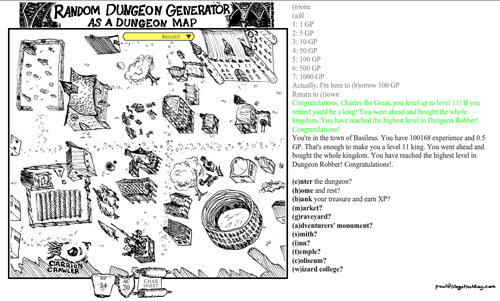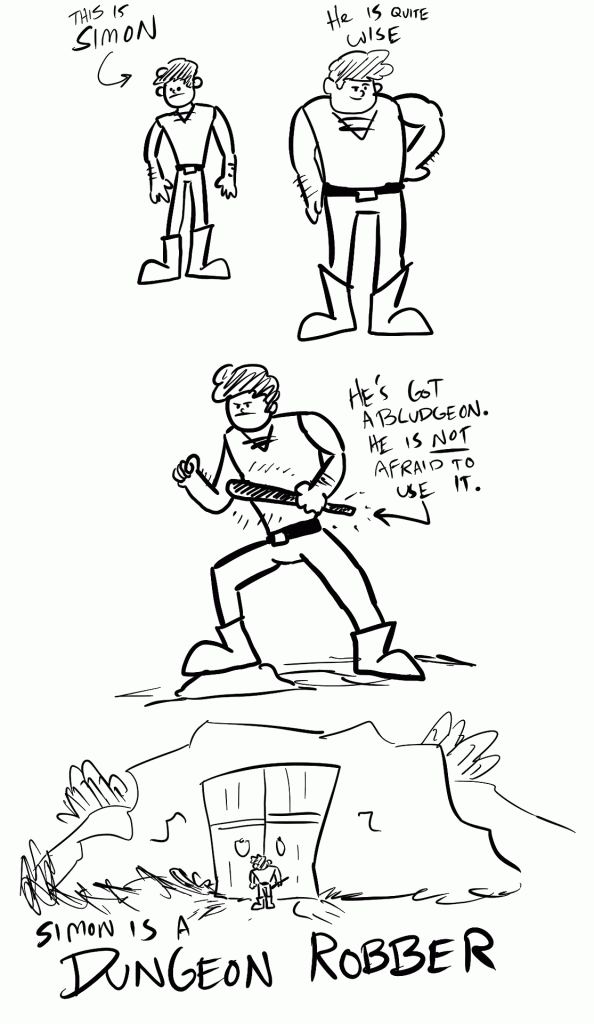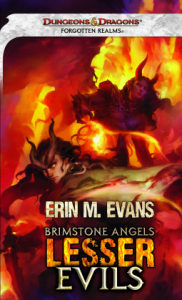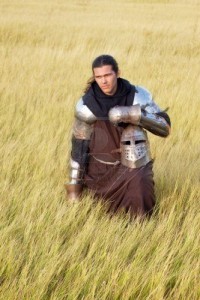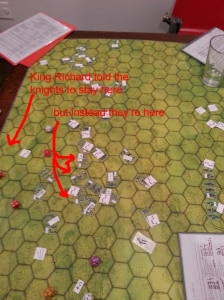Strategic Review #2 featured the first appearance of the Ranger class, by Joe Fischer. I think it’s one of the few pieces of OD&D that Gygax didn’t have a hand in writing.
Gygax says: “Joe Fischer played in my group, and he did an article in THE STRATEGIC REVIEW introducing the Ranger Class for the D&D game. From that I built the AD&D version.”
Let’s compare the Strategic Review ranger with the PHB ranger to see how much building Gary had to do.
Alignment
From Strategic Review:
Rangers are a sub-class of Fighting Men, similar in many ways to the new sub-class Paladins, for they must always remain Lawful or lose all the benefits they gained (except, of course, experience as a fighter).
OD&D’s alignments were limited to Lawful, Neutral, and Chaotic, with Lawful often standing in for Good. In AD&D, where we had the full dual-axis alignment system, “All rangers must be of good alignment, although they can be lawful, chaotic, or neutral otherwise.” The main literary model of the ranger, Aragorn, is probably Lawful Good, so I guess he can play in OD&D and AD&D games.
Prerequisites
From Strategic Review:
Strength is their Prime Requisite, but they must also have both Intelligence and Wisdom scores of at least 12 each, and a Constitution of at least 15.
In AD&D, the prerequisites are changed to 13 Strength, intelligence 13, wisdom 13, and consitution 14. Both classes are pretty hard to qualify for, although not as hard as the AD&D paladin (whose stat prerequisites were so demanding that, paradoxically, anyone who claimed to have rolled up a paladin was by definition a liar and not worthy of paladin status).
Hit points
The Strategic Review Ranger got 2 Hit Dice at level 1, while everyone else got one (“either with the standard [d6] system or the alternate system which allows fighters 8-sided dice”). That’s what happens when you let a player design his own class: you get power creep. Oddly, when Gygax revised the class for AD&D, he let the ranger keep its weird bonus level die, but to balance it, he gave the ranger d8 Hit Dice while the other fighter classes got upgraded to d10s. It sort of balances out, but it gives rangers a big lump of HP at level 1.
Spells
The SR ranger got alternating levels of cleric and magic-user spells starting at level 8, so that a 13th-level ranger could cast level 3 cleric and level 3 magic-user spells. The AD&D ranger had a slightly slower progression, starting at level 8 and ending at level 17. Also, instead of cleric spells, the ranger got druid spells. That makes sense: druid spells didn’t exist when Joe Fischer first wrote the class, but they’re more woodsy and ranger-appropriate than cleric spells. I’m sure Joe Fischer approved.
Disadvantages
In older versions of D&D, mechanical bonuses were often balanced by role-playing and campaign-world restrictions.
From the Strategic Review:
Until they attain the 8th level (Ranger-Knight) characters in the Ranger class are relatively weak, for they have a number of restrictions placed upon them. These restrictions are:
– They may own only that which they can carry with them, and excess treasure or goods must be donated to a worthy cause.
– They may not hire any men-at-arms or other servants or aides of any kind whatsoever.
-Only two of the class may operate together.
The AD&D ranger kept most of these rules intact, except that “no more than three rangers may ever operate together” (emphasis mine). Did Gary end up with some D&D group where three players wanted to be rangers? Heaven help him.
XP Bonus
From the Strategic Review:
They receive no regular bonuses for advancement due to ability, but they automatically gain 4 experience points for every 3 earned.
OK, Joe, this is a bad rule. Granting an across-the-board 25% bonus to ranger XP is exactly the same as lowering the XP needed for each level, except it’s much more of a pain in the butt this way, since players have to fiddle with their XP every time they get it. Now if this rule were introduced into 3e, where every class uses the same advancement chart, it would actually mean something (and it would still be a bad rule).
Gygax, an experienced game developer, of course removed this rule in AD&D. He also lowered the XP needed for level advancement to compensate.
Tracking
From the Strategic Review:
They have the ability to track the path of most creatures when outdoors, and even in dungeons they are often able to follow:
There follows charts for the ranger’s ability to track in the dungeon and the wilderness – the dungeon subsystem is based on the d6 and the wilderness subsystem is based on percentile dice.
When Gygax reprinted the tracking subsystems in AD&D, he converted them both to percentile systems.
Surprise
From the Strategic Review:
Because of their ability to track Rangers also are difficult to surprise, requiring a roll of 1 instead of 1 or 2.
In AD&D, Gygax saw that, and raised it: “Rangers surprise opponents 50% of the time (d6, score 1 through 3) and are themselves surprised only 16 2/3 of the time (d6, score 1).
Damage Bonus
From the Strategic Review:
All Rangers gain a special advantage when fighting against monsters of the Giant Class (Kobolds – Giants). For each level they have gained they add +1 to their damage die against these creatures, so a 1st Level Ranger adds +1, a 2nd Level +2, and so on.
(I guess this is because Aragorn is really good at killing orcs?) Gygax kept this rule in AD&D. It’s especially good at low level because so many low-level D&D battles are against kobolds, goblins, orcs, and hobgoblins. That plus the 2d8 HP at level 1 make the ranger a low-level juggernaut.
Special Followers
From the Strategic Review:
-From 2-24 followers will join the character as soon as 9th level is
attained by him. These followers are detailed later.
[…later…]
Special Followers: For each of the 2-24 followers the Ranger gains
a dice roll must be made to determine what the follower is. Further
dice rolls to determine type, class, and/or level will also be necessary.
Type
01 – 60 Man
61 – 75 Elf or Half-Elf
76 – 90 Dwarf
91 – 99 2 Hobbits
00 Extraordinary (see below)
Class (Men Only)
01-50 Fighter
51-75 Cleric
75-95 Magic-User
95-00 Thief
Multi-Class (Elves Only)
01 – 50 Fighter
51 – 75 Fighter/Magic-User
76 – 90 Magic-User
91 -00 Fighter/Magic-User/Thief
|
Level of Ability (Roll for each)
01 – 50 2nd Level
51 – 65 3rd Level
66 – 80 4th Level
81 – 90 5th Level
91 – 99 6th Level
00 7th Level
|
Extraordinary Followers
01 – 20 Ranger, 3rd – 7th Level
21 – 40 Lawful Werebear
41 – 55 2 Unicorns
65 – 70 Pegasus
71 – 80 Hill Giant
81 – 90 Stone Giant
91 – 99 Golden Dragon
00 Take two rolls ignoring any 00%u2019s which might come up
A couple of things to note on the Extraordinary Followers table:
-2 Hobbits? Why do hobbits come in pairs? Well… there is some precedent, in Merry and Pippin… and Frodo and Sam… I withdraw my objection.
-2 unicorns?? Why do unicorns come in pairs? The second one is wasted, unless you plan to have them pull your coach. Or start a unicorn breeding program, I guess.
Unicorns are a symbol of all that is wild and unattainable. It just seems like a waste to have two of them. It’s like finding two philosopher’s stones.
-If you roll a 91-99 on the Extraordinary Followers chart, you get a GOLDEN DRAGON. How awesome is that. You’ll pretty much be the baddest ranger in the room (which isn’t saying much, since only 2 or 3 rangers may ever share a room).
The odds of getting a golden dragon aren’t very good: each follower has a 1 in 1000 chance of being a golden dragon. Rangers do get 2-24 followers, though, so the odds are actually better than 1 in 100.
The kinds of people who “honestly rolled up” a character good enough to be a ranger, though, probably ended up with 2 or 3 golden dragons.



